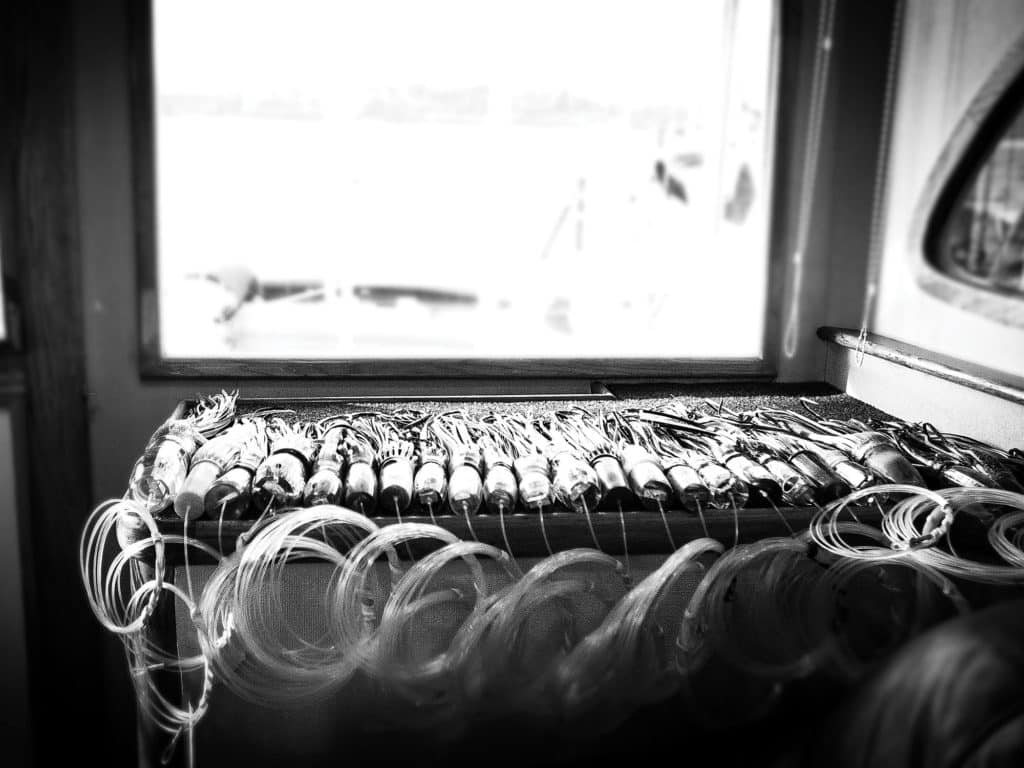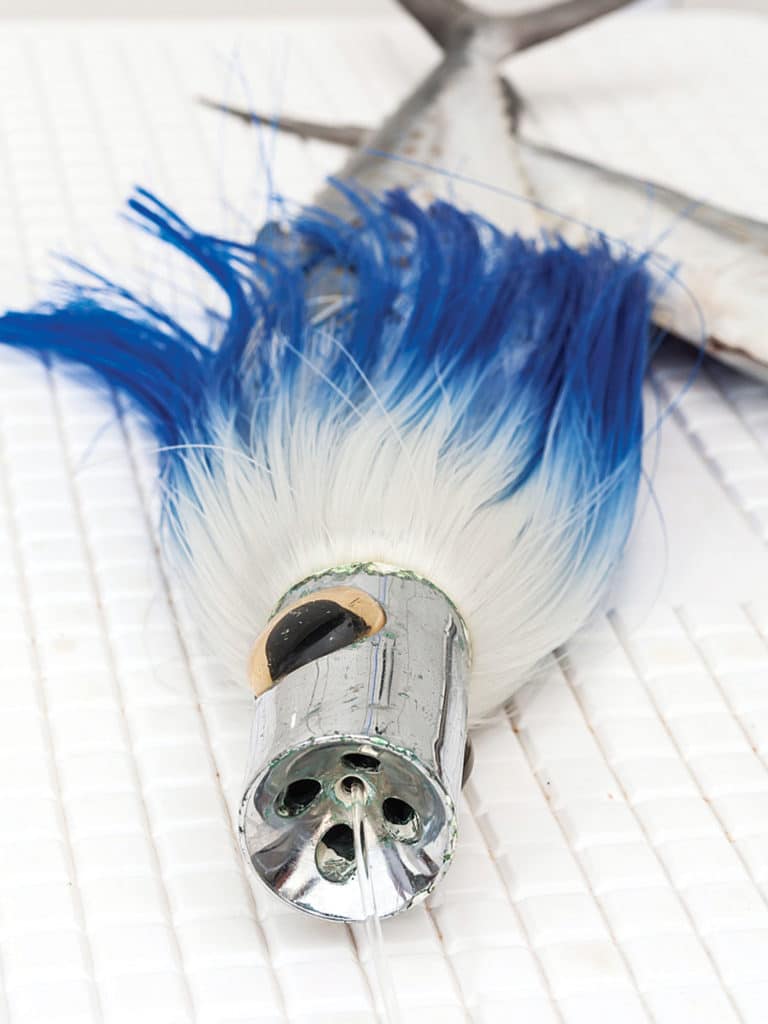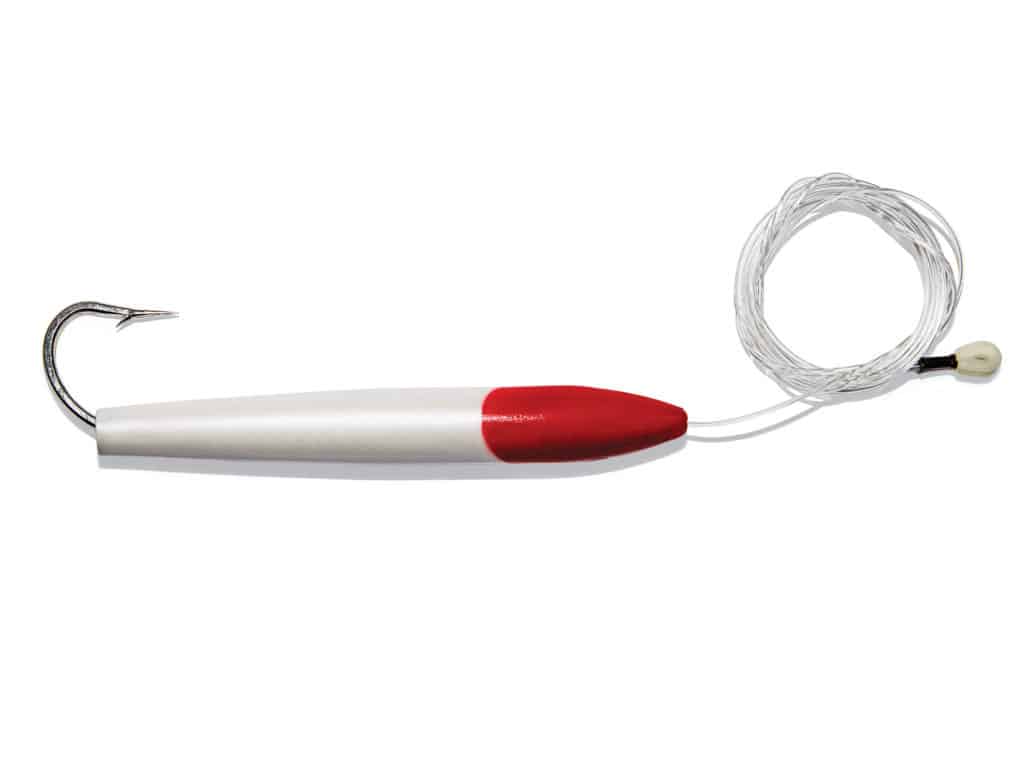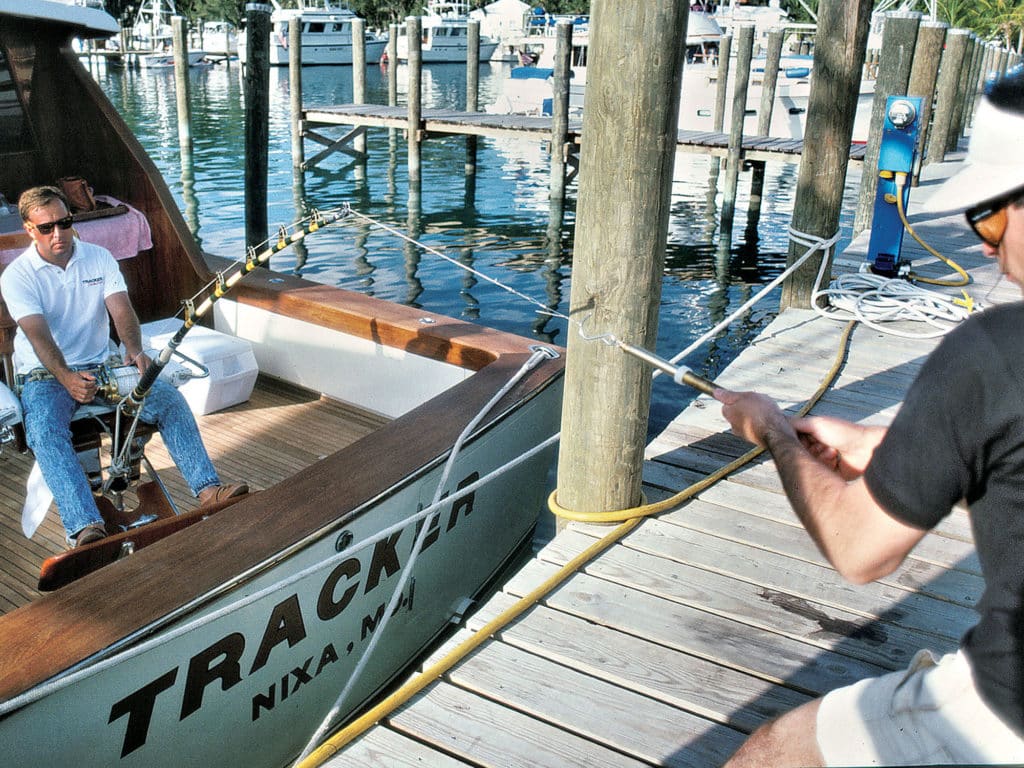
Before Billy Maxwell and I got married, I followed him from Virginia to Hatteras Island, North Carolina, in the spring after the Bonney brothers were kind enough to assign him a boat slip. At the time, Billy’s first Tuna Fever was the old Gannett, built in 1974 by Ace Harris of Marshallberg, North Carolina. She had hosted President Jimmy Carter, and when her hull was stripped to bare wood, 11 white marlin bills were found embedded in the juniper.
But I believe that hull’s biggest claim to fame came in the unlikely form of an angler from Maine who also spent his spring in Hatteras. Art LaPage fished on boat after boat in search of the captain who would give him a shot at a blue marlin. “We hooked that blue one on a mackerel on wire leader off the short rigger,” says Billy. “Mr. LaPage released the fish and then bought the boat — lock, stock and barrel. I only pined for the rods.” LaPage bought that boat and everything on her, except for a Joe Yee original Super Plunger lure with a pearl head and mackerel skirt that I had purchased for Billy as a gift. At the time, it cost $92, and I made sure that it was excluded from the sale. Today, there is one on eBay, no skirt, bid up to $283, with five days left.
Old-School Teaser

“Everything has changed so much with the circle hooks,” says Capt. Barry Daniels, of Skirt Chaser. “We hardly ever drag anything old‑school when we are marlin fishing. But I remember the old days fishing as a kid.”
Daniels rattles off a laundry list of old lures for blue marlin fishing and reminisces about the Old Boss teaser that was a favorite on his father’s charter boat, Temptress.
“You just can’t compete if you don’t use the double dredges, and all the baits are naked now because of the circle hooks,” Daniels says. But he adds that his preferred pitch bait for a big blue marlin remains the same as in days gone by: a big Spanish mackerel, albeit with a circle hook these days. He remembers the days of No. 19 wire leaders on 50Ws and ballyhoo with SeaWitch skirts. “We eventually changed from wire to 80-pound monofilament leader,” Daniels says. “And then we dropped to 60-pound leader with the circle hooks. We don’t worry about the chafe anymore because you hook them in the jaw. The lighter leader makes less resistance for the fish to feel, and using 20-pound-test makes less drag in free-spool.”
The Old Standby

Now, you might argue that the legendary Ilander lure — commonly known as the Hawaiian Eye — is not old-school, but I say that any lure that hit the water when I was in the fourth grade has got to be at least marginally oldish. And the whole point of this exercise is to highlight those tried-and-true baits that are called upon, even today, in a pinch.
Even though dredges are certainly now standard equipment, the old-school tackle box twist on the modern-day double- and triple-bar dredge is the tried-and-true Ilander Hawaiian Eye lure. “I’ll use a regular Ilander with my mullets and the Juniors on a large ballyhoo dredge,” says Daniels. “Blue and black or purple on the big ones and old-school blue and white on the ballyhoo, and I do like a squid chain off the riggers — pink on one side and green on the other.”
Classic Cedar

“That’s one thing that hasn’t changed around here since 1974,” says Billy McCaskill, of Whalebone Tackle in North Carolina. “Except there are more choices now.” McCaskill explains that even though there are so many different Hawaiian Eyes to choose from now — for years, the display was only 3 feet, and now it takes up nearly a whole wall — people buy only one: “The one they caught the fish on that day. To everyone, that’s the only Hawaiian Eye that will catch!”
Whalebone is the kind of old shop that you love. The go-to place for locals and visitors alike, it is strategically located on the causeway right in between the Oregon Inlet Fishing Center and Pirate’s Cove Marina. “They don’t make the old Green Machine anymore, but there is a look-alike,” McCaskill says. “And they sell. So do the cedar plugs and the squids for the chains.” You gotta love a classic, and McCaskill certainly is one of those as well.
In the Tuna Box

“Heather, you are just not going to find what you are looking for — unless you go tuna fishing,” Capt. Charles Haywood, of Rigged Up, explains. “It’s all new-school, and it’s all still evolving. When I quit mating back in 1996, we were just starting to pull dredges on the downrigger. Now you need a $3,500 electric reel just to pull them.” The colors are new too, says Haywood. “It used to be no color, and now mine are rigged so that I can change my skirts out depending on the conditions. So it keeps evolving.” Captains also special order their Hawaiian Eyes with colored heads and special skirts. Call it custom old school. Haywood went on to revisit his old teasers, chains with a Hawaiian Eye on the back or an Old Boss or Mumford. Old school meant lots of action and lots of color. “When I mated with Tony Tillett on Carolinian, we caught three blue marlin in one day and saw them all to the same teaser: a red Voss with a red sparkly skirt and a red eye,” says Haywood. “Tony always put a single-hook squid on the flat line, and we hooked all three on that.

“Today, we drag some Bart teasers and a Monster Breakfast,” he continues. “That one is like a big bonito just cutting through the water.” Haywood says if the charter boats could spend the whole season just looking for blue marlin, who knows what they would find? “We don’t just try to catch big fish; we catch to fill the box. And it’s never been done here, just riding around for blue marlin.”

Older than Dirt
“I always have cedar plugs around,” says Haywood. “But my favorite is a green spreader bar with a Green Machine on the end.” That rig will save the day more times than not and also saves some money on bait. “When the tuna fishing is really good,” he adds, “I drag a daisy-chain teaser, but I’ll put a Green Machine on the end with a hook. If they pile on that, they get their feelings hurt!”
“I like a cedar plug when I’m blackfin tuna fishing,” adds Daniels. “And SeaWitches for yellowfin.” Daniels offers Capt. Bull Tolson’s favorite black SeaWitch with a red head or red and white on the long shotgun with a blue head. Then he offers up Billy’s favorite, which is crystal hair and a purple skirt — but he manages to get out of our interview without mentioning what he pulls in his spread.
When Wire was the Boss and Only One Guy Knew How to Rig Dacron

Every old Oregon Inlet story I’ve ever heard championed wire pulled on a 50-wide. Sounds like they dragged that rig for white ones and tuna and hooked their share of blue ones on the same. Many a captain has spliced an 80 onto a 50 in a desperate attempt to catch the one that usually got away.
“Seems like everything was a No. 9 wire on a No. 6 J-hook way back then,” says Capt. David Swain, of High Return. “We had a 9/0 or a 6/0 Penn to rig with wire. I remember one time I ran Temptress for Steve Daniels in a tournament, and he said only if we rigged with monofilament.” That was a first for Swain.
Today, almost every captain has a story about the last time a wire rig broke his heart. “I’ll never use wire again,” says Capt. Tom Krauss. “We hooked a grander in the Pirate’s Cove Tournament, and the wire broke right at the transom,” he laments. “Right there, where we could almost touch it.”

“I always used a wire leader in Australia,” says deckhand Steven Hall. “And I would rig a mackerel here on .040 and double-twisted wire for a swimming bait.” Not many tuna charters get to spend the day with a mate who has chased big marlin all over the world, but Tuna Fever patrons do. Hall has grown up into a humble man with awesome stories who was finally ready to stay home after fishing the Canaries, Panama, the Azores — you name it.
“Now I will put out a cedar plug for blackfin and a Green Machine on a spreader bar for yellowfin,” Hall explains. But, when asked about his lures, he simply states, “We just don’t fish for blue marlin much.” Capt. Dave Peck mentioned the Puerto Rican Prowler and a C&H Super Charger that have become his favorites in the spread, but Hall was quick to explain to me that lures depend on the sea conditions. “My favorite was the one that was getting bites.” Well, yeah. “I like lures because you can use J hooks in them,” adds Capt. Dickie Harris. “But you can’t just throw one out while you are white marlin fishing anymore because we don’t troll fast enough.” It’s just my guess, but maybe hundreds of dollars of chandeliers are slowing you down.
The First Braid

When Dacron hit the docks in Virginia Beach, Virginia, it was Ray Temple on the 41-foot Viking Pursuer who people cajoled into sharing the secrets of rigging with the stuff. Temple and his crew fished like professionals, and there wasn’t a day on the ocean that wasn’t a tournament for them. And there wasn’t a new bit of tackle that didn’t escape their scrutiny. “Today we still use Dacron, but a lot of mates like a hollow-core line,” explains Hall. “With a high-test strength but a smaller diameter, the hollow-core products allow you to load the spool and then splice in your leader. You get much more line on the reel than with Dacron.
“But I figure if you’ve got a guy who can drive the boat, then you don’t need that much line,” Hall says. “I still like 50-pound Dacron as backing and mono for the leader, but we rig to the target species.” Hall explains that they rigged their big baits on straight Dacron in Australia. With no stretch in the line, the hook set better. Pretty cool. The Tuna Fever crew also uses 200-pound Dacron backing to 400-pound mono main line on its green stick.
“What’s this article called, anyway?” Hall says, and when I tell him, he asks me if I’m including belly strips. “What’s that?” I say, and I get a cool story of record fishing in Panama. The bait of choice: the strip bait. “The conditions have to be right, but they work great when the fish are there,” he explains. Today, strip baits are still an important part of the spread when big mahimahi are on the move, and paramount to the success of bailing when the boat is backing into schools. It just goes to show that tried-and-true fishing techniques do evolve as well.







